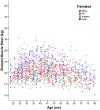Sarcopenia, dynapenia, and the impact of advancing age on human skeletal muscle size and strength; a quantitative review
- PMID: 22934016
- PMCID: PMC3429036
- DOI: 10.3389/fphys.2012.00260
Sarcopenia, dynapenia, and the impact of advancing age on human skeletal muscle size and strength; a quantitative review
Abstract
Changing demographics make it ever more important to understand the modifiable risk factors for disability and loss of independence with advancing age. For more than two decades there has been increasing interest in the role of sarcopenia, the age-related loss of muscle or lean mass, in curtailing active and healthy aging. There is now evidence to suggest that lack of strength, or dynapenia, is a more constant factor in compromised wellbeing in old age and it is apparent that the decline in muscle mass and the decline in strength can take quite different trajectories. This demands recognition of the concept of muscle quality; that is the force generating per capacity per unit cross-sectional area (CSA). An understanding of the impact of aging on skeletal muscle will require attention to both the changes in muscle size and the changes in muscle quality. The aim of this review is to present current knowledge of the decline in human muscle mass and strength with advancing age and the associated risk to health and survival and to review the underlying changes in muscle characteristics and the etiology of sarcopenia. Cross-sectional studies comparing young (18-45 years) and old (>65 years) samples show dramatic variation based on the technique used and population studied. The median of values of rate of loss reported across studies is 0.47% per year in men and 0.37% per year in women. Longitudinal studies show that in people aged 75 years, muscle mass is lost at a rate of 0.64-0.70% per year in women and 0.80-00.98% per year in men. Strength is lost more rapidly. Longitudinal studies show that at age 75 years, strength is lost at a rate of 3-4% per year in men and 2.5-3% per year in women. Studies that assessed changes in mass and strength in the same sample report a loss of strength 2-5 times faster than loss of mass. Loss of strength is a more consistent risk for disability and death than is loss of muscle mass.
Keywords: aging; dynapenia; muscle aging; muscle atrophy; muscle quality; sarcopenia; skeletal muscle; strength.
Figures
References
-
- Al Snih S., Markides K. S., Ottenbacher K. J., Raji M. A. (2004). Hand Grip strength and incident ADL disability in elderly Mexican Americans over a seven-year period. Aging Clin. Exp. Res. 16, 481–486 - PubMed
-
- Aloia J. F., Mcgowan D. M., Vaswani A. N., Ross P., Cohn S. H. (1991). Relationship of menopause to skeletal and muscle mass. Am. J. Clin. Nutr. 53, 1378–1383 - PubMed
-
- Bajekal M., Wheeler L., Dix D. (2006) Estimating residents and staff in communal establishments from the 2001 census. Health Stat. Q. 31, 42–50 - PubMed
Grants and funding
LinkOut - more resources
Full Text Sources
Other Literature Sources
Medical


